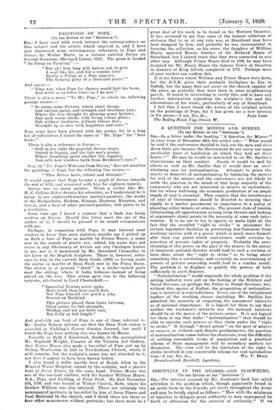PAINTINGS OF POPE.
[To THE EDITOR OF THE " SPECTATOR."] Ent, —1 have read with much interest the correspondence on this subject and the article which inspired it, and I have just discovered some contemporary references to Pope and Jervas by Walter Harts, in a volume entitled Poems on Several Occasions (Bernard Lintot, 1727). The poem is headed " An Essay on Painting " :—
" But al! how long will nature ask to give A soul like his, and bid a wonder live?
Rarely a Titian or a Pope appears,
The forming glory of a thousand years? "
And again:-
" Time was, when Pope for rhymes would knit his brow,
And write as tasteless lines—as I do now."
There is also a poem " To Mr. Pope," in which the following passage occurs :- " So seems some Picture, where exact design, And curious pains, and strength and sweetness join : Where the free thought its pleasing grace bestows, And each warm stroke with living colour glows; Soft without weakness, without labour fair; Wrought up at once with happiness and care!"
Pope must have been pleased with the poems, for in a long list of subscribers I found the name of " Mr. Pope" for " four books."
There is also a reference to Jervas :-
" Still in his right the graceful Jervas sways,
Sacred to beauty, and the fair one's Praise, Whose breathing paint another life supplies,
And calls new wonders forth from Mordaunt's eyes."
Gay, in "Mr. Pope's Welcome from Greece," does not mention the paintings of Pope, but the following line occurs :-
"Thee Jervas hails, robust and debonair."
It would appear that Pope became a pupil of Jervas towards the end of 1713, and remained with him for eighteen months.
Jervas was no mean painter. When a writer like Mr. II. C. Collins Baker devotes his attention, as I understand he is doing, to our eighteenth-century portrait-painters, the works of the Richardsone, Hudson, Ramsey, Hayman, linapton, and Jervas, and a host of other portrait-painters, will prove to be a revelation.
Some time ago I heard a rumour that a book was being written on Jervas. Should this letter meet the eye of the author of it, I should be pleased if he would communicate with me.
Perhaps, in connexion with Pope, it may interest your readers to know that some eighteen months ago I picked up in Bath a bust of Pope in marble by Prince Hoare, a name new in the annals of plastic art; indeed, his name does not occur in any Dictionary of Artists nor any Catalogue known to me, nor is it mentioned by Mr. Beresford Chancellor in his Lives of the English Sculptors. There is, however, refer- ence to him in the current Bath Guide (1919) as having made the statue in marble of Beau Nash now in the Pump Room. The statue is at present " skied" in a niche—indeed quite near the ceiling, where it looks hideous—instead of being placed on the line. This statue gave rise to the following epigram, attributed to Lord Chesterfield :--
"Immortal Newton never spoke More truth than here you'll find; Nor Pope himself e'er pen'd a joke Severer on Mankind.
This picture placed these busts between, Gives satire its full strength; Wisdom and wit are little seen, But Folly at full length."
And probably my bust of Pope is one of those referred to. Mr. Austin Dobson informs me that the Beau Nash statue is recorded in Fielding's Covent Garden Journal, but until I found the Pope bust nothing else was known by Hoare.
Recently in Bath I discovered, thanks to the accomplished Mr. Reginald Wright, Curator of the Victoria Art Gallery, that Prince Iloare also made a bas-relief of Pope put up by Bishop Warburton in 1761 in Twickenham Church, where it still remains, but the sculptor's name was not attached to it, nor does it appear to have been known before. '
I also found a noble marble bust of Ralph Allen in the Mineral Water Hospital, signed by the sculptor, and a plaster bust of Jerry Pierce, by the same hand. Prince Hoare was ene of the constant visitors, with his brother William Hoare, ILA., Pope, and Fielding, at Prior Park. He died November ath. 1769, and was buried at Walcot Church, Bath, where his brother William was also" interred. There are certainly two monumental portraits in bas-relief by him of Jerry Pierce and Paul Bertrand in the church, and I'think there are three or four other monuments without portraits; but there must hi a great deal of his work to be found in the Western Counties. It has occurred to me that some of the famous collection of statuary that is, or at any rate was, at Stourhead may have been designed by him, and probably he was instrumental in forming the collection, as his niece, the daughter of William Hoare, married Henry, brother of Sir Richard Hoare of Stourhead, but I cannot trace that they were connected in any other way. Although Prince Hoare died in 1769, he may have designed for Mr. Henry Hoare the famous Tower at Stourton in memory of King Alfred, completed in 1772. Perhaps some of your readers can confirm this.
It is not known where William and Prince Hoare were born, but the D.N.B. gives their probable birthplace as Eye in Suffolk, but the name does not occur in the church register of the place, so probably they were born in some neighbouring parish. It would be interesting to verify this, and to have any further information regarding the sculptor's life and the whereabouts of his works, particularly of any at Stourhead.
I feel that I must thank the writer of the original article on the paintings of Pepe, for it has given me a new interest
in his poems.—I am, Sir, &c., Iona LANE. The Bodley Head, Vigo Street, W.










































 Previous page
Previous page